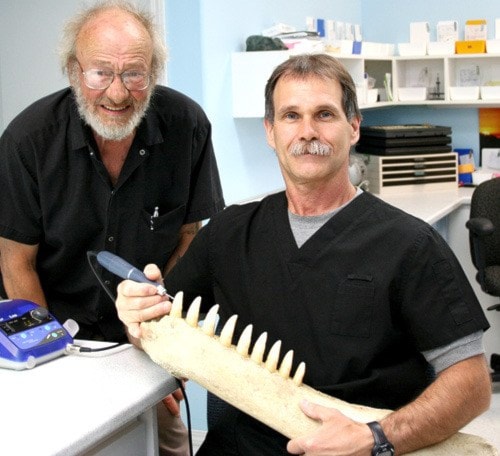Most patients who come into Paul Gagnon’s office are human – and alive – but, sometimes life or death, pitches a curveball.
The owner of Van Isle Denture Clinic in Nanaimo was recently handed a project he could really sink his teeth into – a set of jaws from a dead orca whale.
The jaws will be used in Build a Whale, a mobile teaching display being assembled by the Strawberry Island Marine Research Society, based at the Clayoquot Sound UNESCO World Biosphere Reserve.
The display consists of a complete orca skeleton assembled on a backdrop of a whale’s anatomy showing how the animal’s skeleton and internal organs are arranged.
The skeleton came from a whale that was found dead off the west coast of Vancouver Island. Over an extended period of exposure to air the skeleton lost moisture, some of the teeth cracked and chipped and needed restoration.
Gagnon said he worked on the teeth between jobs for a couple of months, estimating he put in about three solid days of work over that time, which included laying down and curing the restoration material, shaping and polishing it.
“It’s a light-cured material, exactly the same as what you would use on humans, but you can only put it on two millimetres thick. It’s very small layers or the light doesn’t penetrate and bond,” Gagnon said. “For some of these big restorations, I had to put maybe five, six or seven layers and just kind of layer it on and light cure it, kind of adding it and building it up.”
CG America and Dentsply Canada donated the restoration materials.
Rod Palm, principal investigator for the marine research society, said he met Gagnon when he was in Nanaimo.
“By chance, I was in the eye-care clinic and noticed Paul’s shingle next door, so I made an appointment for new dentures,” Palm said in an e-mail. “Turned out Paul had spent some time in Tofino, we got reminiscing and I brought up the damaged killer whale teeth, thinking he may be able to recommend a repair medium. But he got stoked and, thankfully, ended up doing the deed himself.”
Being able to display the teeth is important because the wear on orca teeth differentiates orcas with long, sharp teeth that feed on salmon in waters close to the Island versus those that live and feed offshore and survive on a diet of sharks. Shark-eating orcas have short, flat teeth, worn down over their lifetimes from grasping the hard, sandpaper-like skin of the prey they consume.
“The jaw is a prop for the overall project in that it is used as an example of the morphological variance between the various cultures of killer whales and it just looked bad in its former condition,” Palm said.
To learn more about the Build a Whale project, please visit the project website at http://buildawhale.wordpress.com/.
